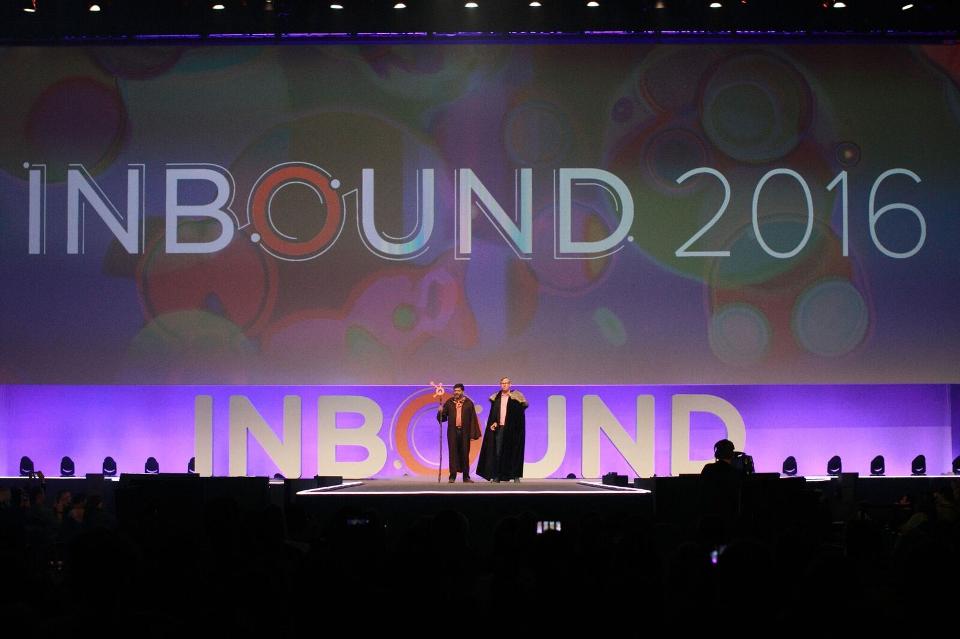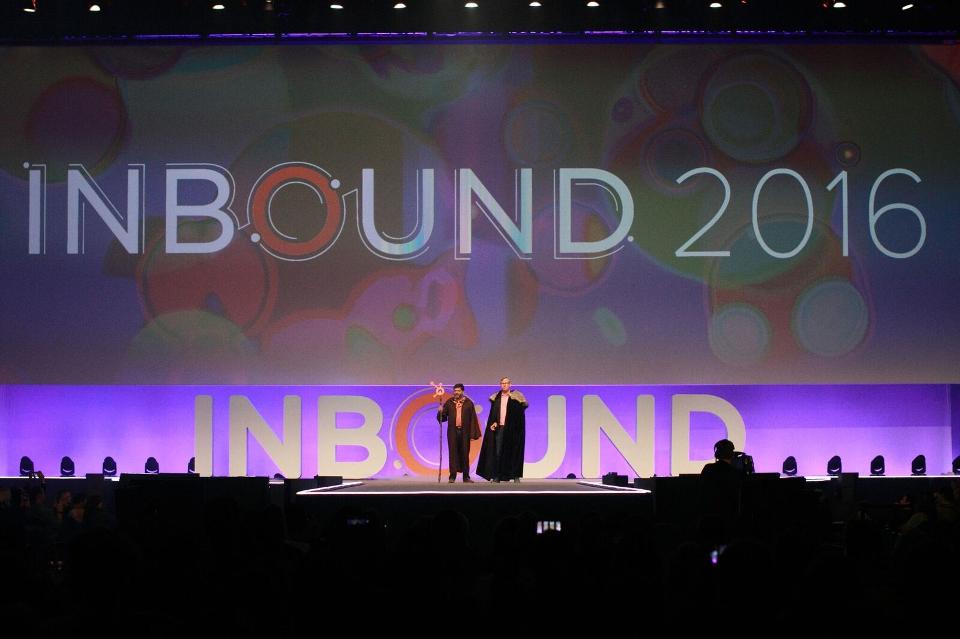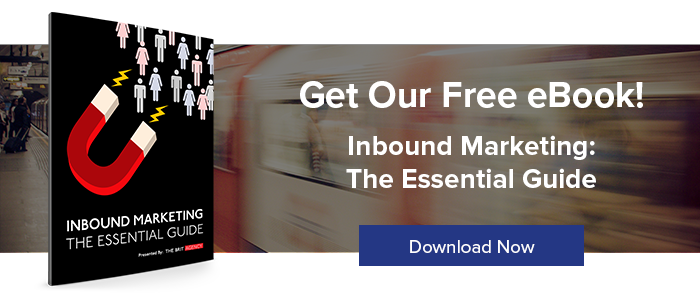
We're still digesting the huge amount of information we picked up from INBOUND16 in Boston. Even though I made lots of notes, attended loads of conference sessions, and got tons of new Inbound Marketing ideas, I needed to sift through all the content to pick the top 5 trends I think you need to look out for in 2017.
Now we're into the 2017 planning season, the time is perfect to consider how these 5 Inbound trends will impact your business in 2017.
1. Video Gets Embedded Into All Aspects Of Inbound In 2017
2. SEO Is About To Change Big Time In 2017 - Be Prepared
3. The Sales & Marketing Process Is Finally Unifying Around The Inbound Methodology
4. Inbound Marketing and PR will be inseparable in 2017
5. LinkedIn & Facebook PPC Advertising - They're Both Strategic And Necessary For Inbound Marketing In 2017
1. Video Gets Embedded Into All Aspects Of Inbound In 2017
There's a lot happening with video and Inbound Marketing, probably too much to talk about here (expect a few more blog posts on video soon). As you're well aware, video is creeping into everything, and consumers and businesses love it and want more, so all the data is pointing to continued rapid growth of video (See the 5 Online Video Trends From Google).
For any brand, or business, that has yet to get serious about video in their Inbound Marketing plans, time is of the essence. Chances are, some (or all) of your competition are already utilizing video in some way - video content is no longer an option.
To make sure you’re one step ahead, I've compiled a list of 10 video trends we heard at INBOUND16 that you need to be aware of for 2017.
1. There will be a massive increase in Facebook video viewership, resulting in the Facebook platform becoming an entertainment platform alternative. Facebook's goal is to keep people on their platform for longer, and to take YouTube head-on.
2. More live streaming videos than ever - Facebook Live, the just launched Instagram Live, and Periscope are now well established and can provide in-the-moment video experiences, so now businesses are trying to figure out how to do live streaming events to add to their marketing.
3. Sales will use more video in their sales process to inform and educate prospects. Sales reps can now send out informative, contextual and personalized videos that can help prospects successfully move through the buyers journey.
4. As video content and video blogging grows - the process of creating, story telling and writing content will change - video bloggers will be in demand, more so than blog writers.
5. There's an exponential increase in video apps such as Snapchat and Instagram. These apps are becoming hugely popular with younger audiences, and businesses will need to figure out how to get on board too.
6. Videos will need to entertain - Videos are not just to be informative, but they also have to be liked to get shared.
7. Virtual Reality is becoming mainstream - 360 degree videos and VR (virtual reality) are going to breakthrough in 2017, how will marketers respond?
8. This one has been on my list for years, but never seems to get traction, so maybe 2017 is the year - Email & video finally team up to become contextually popular.
9. Videos will have to have more context and relevancy, with micro-targeting becoming the norm. This is the principle of Inbound being applied to video, they have to be relevant and targeted at the persona in order to get them engaged to respond.
10. Video is now a big part of Inbound Website design as part of the online conversion process - but what does the conversion data look like? We're hearing mixed reviews about the value of video hero images, where to place CTAs in videos, and lower CTRs from video - so we're watching carefully. In 2017 we need to have the answers on what types of video works best and what doesn't, fortunately there's a lot of new technology coming on stream to help us - Wistia and Hotjar are some we use.
2. SEO Is About To Change Big Time In 2017 - Be Prepared
Keyword optimization for Google alone is not enough anymore.
I'm not saying that keywords aren't important, they are. It's just that we have more search engines to deal with; YouTube,Amazon, Facebook (Facebook now sees 2 billion searches per day, up from 1.5 billion a year ago, compared to 3.5 billion a day from Google), and many other platforms are quickly expanding their search to keep visitors on their sites longer. This means that we have to think about optimizing content for numerous search platforms at the same time - It's not just a Google world out there anymore.
Additionally, the way people are searching is changing - we've moved from simple keyword search, to keyword phrase search, to now asking search engines detailed natural language questions of exactly what we are looking for, for which we expect detailed responses and answers. This means we have to manage our keywords differently, and we have to think of keywords in terms of matching questions and answers. To do that we have to know their persona, and what they do and think, in even more detail.
Search is now more getting more complicated because of Voice Search.
Voice Search is quickly becoming mainstream, with Google Now, Siri and Amazon's Alexa leading the way. Most of the voice searches are made with natural language queries, which are often different and longer than traditional, typed queries. Creating content for voice searcher intent is harder, we need know what they are looking for, and this is yet another twist with SEO, and this will become a huge opportunity for SEO in 2017.
As more searches are now taking place from mobile devices rather than traditional desktop devices, Google is continuing to refine its search so that optimized mobile responsive websites will get preferential and priority rankings.
This time, Google has not just announced a dedicated index for mobile SERP's, but has also said it is going to be their primary index, which means that it will be updated more frequently.
The separate mobile index will be a challenge as to whether to optimize for desktop or mobile. Should they have 68-70-character page titles that display on both desktops and mobile? Or should they embrace the 78-character mobile titles and take advantage of long-tail and natural language key phrases?
SEO is now an Inbound team effort and no longer resides with a techie SEO expert sitting in the corner. We now have to consider the bigger SEO picture with an analysis of all types of content, the website UX, mobile, pop-ups, E-commerce, the buyer journey, social media, video and all other pertinent areas need to be considered - this is way beyond the scope of the old school SEO techie. Having your team put all these pieces together is key in optimizing your page SEO.
To help us with some of these upcoming SEO changes, we had some good SEO mobile news from HubSpot at INBOUND16.
They will be implementing AMP ready blogs on the HubSpot platform in the new year! AMP (Accelerated Mobile Pages) is a Google-backed technology that speeds up the loading time for mobile pages to a remarkable 0.7 seconds (median time). This increased page speed will have a positive impact on SEO, as load speed for the new mobile search index will be crucial. And the AMP symbol will show in the search results which pages will be faster to load on mobile encouraging users to click the faster search result listing.
3. The Sales & Marketing Process Is Finally Unifying Around The Inbound Methodology
We saw this coming last year, but 2017 will see Inbound Sales grow huge momentum and develop into a proper discipline and methodology that challenges and changes traditional selling forever. The big change is that marketing is going to play a bigger role with more responsibility for the entire Inbound funnel - top to bottom, lead generation to closing sales. The sales team challenge is that have to adapt and become more focused on helping people to buy, rather than selling.
Clients who understand this and take full advantage of Inbound Marketing and Inbound Sales, from end-to-end will be the most successful.
HubSpot and INBOUND16 developed this concept further and many Inbound Marketing agencies, such as THE BRIT AGENCY, are positioning themselves for integrating Inbound Marketing and Inbound Sales services.
4. Inbound Marketing and PR will be inseparable in 2017
PR is a very important part of Inbound Marketing. The Inbound PR trend treats PR activity as a function of story telling, content development, SEO back-linking, and driving the influentials / blogging process. This is where PR, content, and SEO collide. PR calls this ‘media relations’, Inbound marketing calls this ‘influencer marketing’, and SEO calls this ‘link building’. It’s all 'roughly' the same approach.
For me, going back to the dot com boom days when I ran my own tech PR agency, the Inbound methodology is a natural extension and add-on of what PR already does - brand building, and communicating with key audiences. While communicating information that adds value has always been a must-have in PR because of the newsworthiness criteria, it is really nice to see Inbound Marketing catch up. No more talking at people with a one-size-fits-all PR message, now we can communicate in a personalized manner.
While we all know the high level awareness and visibility that PR delivers, measuring it always turns out to be a murky exercise. With Inbound Marketing and working with an influencers program, we know it’s about driving leads and growing revenue and then proving the ROI.
5. LinkedIn & Facebook PPC Advertising, They're Both Strategic And Necessary For Inbound Marketing In 2017
There are two social media platforms that continue to grow in dominance and offer viable PPC alternatives to Google AdWords - Facebook and LinkedIn.
Facebook has established themselves as a leader in ad technology, even for the B2B market. Their ad units such as Lead Ads, make it easy to drive sign ups, downloads, registrations and more. Their targeting technology is excellent and can help reach exactly the right users to amplify your Inbound Marketing campaigns. Additionally, we heard at Inbound16, that we're still in the early days of Facebook advertising, and therefore the value of buying their ads is strong at the moment, but once the big brands move in, bidding on Facebook ads will send the prices up - so jump on now!
LinkedIn on the other hand, are still a bit behind, they're redesigning their ad platform, and I'm sure Microsoft will assist in making B2B targeting of contacts very worthwhile. LinkedIn is an extremely unique asset for Microsoft, so it will be interesting to see how it gets monitorized.
Meanwhile to respond to this, HubSpot has announced an integration with LinkedIn Sales Navigator giving the CRM platform access to engage with prospects and leads from LinkedIn. HubSpot has also announced that the Ads Add-on will also include, Google Adwords, LinkedIn ads and Facebook, so you're be able to manage keywords, ads, campaigns and analytics all on the HubSpot platform.
Well that's a wrap of some of the exciting stuff we learned at Inbound16. I hope they prove to be a useful heads up for your business moving more into Inbound.
Stay tuned for future blogs that will go over more of what you can expect from Inbound Marketing and Inbound Sales in the new year.
THE BRIT AGENCY is a B2B Inbound Marketing Agency providing Inbound Marketing, Inbound Website Design and Inbound Sales services to companies around the world. We're focused on growing website traffic, qualified leads and sales, using the Inbound lead generation and marketing automation process.
THE BRIT AGENCY is a certified Gold Tier Hubspot Partner, a HubSpot COS certified Inbound Website Design Agency, a Shopify eCommerce Partner, and a certified "Google Badged Agency Partner". We have offices in Toronto and Barrie, Canada, and Salisbury, UK.


